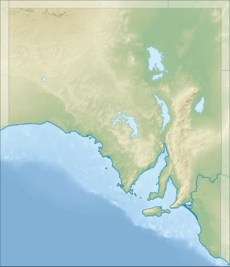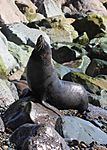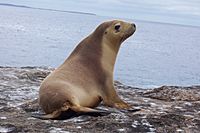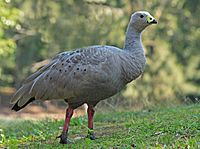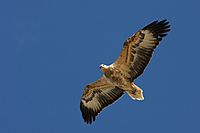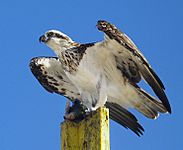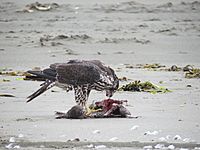Neptune Islands Conservation Park facts for kids
Quick facts for kids Neptune Islands Conservation ParkSouth Australia |
|
|---|---|
|
IUCN Category Ia (Strict Nature Reserve)
|
|
| Nearest town or city | Port Lincoln |
| Established | 16 March 1967 |
| Area | 145.7 km2 (56.3 sq mi) |
| Managing authorities | Department for Environment and Water |
| See also | Protected areas of South Australia |
The Neptune Islands Conservation Park is a special protected area. It covers most of the Neptune Islands in South Australia. These islands are about 55 kilometers (34 miles) southeast of Port Lincoln.
The park was created in 1967. Its main goal was to protect a large group of New Zealand fur seals. Later, the park grew to include the nearby ocean. This was done to manage activities like berleying, which attracts great white sharks. Since 2002, this park has been the only place in Australia where you can legally go shark cage diving to see great white sharks.
What is the Neptune Islands Park?
This conservation park includes almost all the islands in the Neptune group. The only part not included is a small section of the southernmost island. This part is used for a lighthouse.
The park also includes the ocean up to 4 kilometers (2 nautical miles) from the islands. This area is classified as a strict nature reserve. This means it is highly protected.
History of the Park
The Neptune Islands were first protected on March 16, 1967. This was done to save the New Zealand fur seals. The southern island of the North Neptune Islands has one of Australia's biggest fur seal breeding groups.
Other animals also helped make the area a park. These include small groups of Australian sea lions. There are also Cape Barren gooses, white-bellied sea eagles, ospreys, and peregrine falcons that breed or rest here.
In 1997, the park was made bigger. It now included the ocean around both the North and South Neptune Islands. This was done to control how people attract great white sharks.
In 1990, most of Lighthouse Island was added to the park. This happened after the lighthouse became automatic. Only a small area around the lighthouse and a helicopter landing spot were not included.
On November 29, 2012, the waters around the islands also became part of a marine park. This new park is called the Neptune Islands Group (Ron and Valerie Taylor) Marine Park. It adds more rules for how the ocean around the islands can be used.
Visiting the Park
Since 2002, the Neptune Islands Conservation Park is the only place in Australia where you can legally go shark cage diving. This lets you see great white sharks up close.
Only three companies are allowed to offer these shark cage diving tours. They are licensed by the Department of Environment, Water and Natural Resources.
Images for kids
Fauna intended to be protected by the declaration of the conservation park in 1967:


